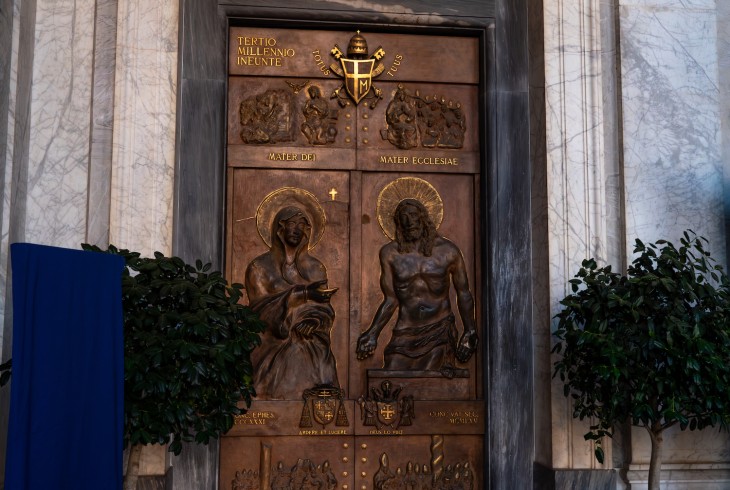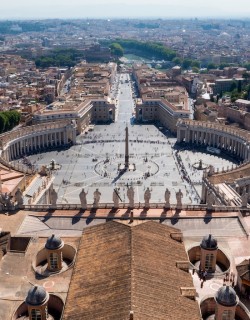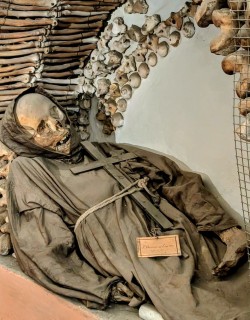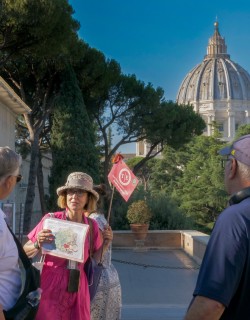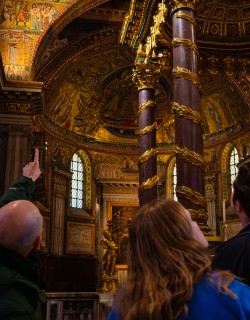Rome is gearing up to celebrate the Jubilee of 2025. With an estimated 35 million pilgrims set to visit the city in the next twelve months, we're here to guide you through - with all the latest up-to-date information so you can make the most of your trip to Rome. In this article, we'll explain everything you need to know about the Holy Doors, the most potent symbols associated with this year of pilgrimage.
What Are The Holy Doors?
For Catholics around the world, the Holy Doors represent the most visually significant symbol of the Rome Jubilee. The opening and closing ceremonies are a highlight in this year of forgiveness, and passing through these holy portals is a vital part of the pilgrimage.
Today, you can find the Holy Doors at St Peter's Basilica, San Giovanni in Laterano, Santa Maria Maggiore, and Saint Paul's Outside the Walls. Over the centuries, Popes have inaugurated other Holy Doors at pilgrimage sites elsewhere in the world, such as at Santiago de Compostela, but the four doors in Rome form the core of the Jubilee pilgrimage.
History of the Holy Doors
The first Jubilee was celebrated by Pope Boniface VIII in 1300; however, the idea of a "Holy Door" arose much later as the concept of the Jubilee itself evolved.
At first, the Pope asked pilgrims and locals to go on pilgrimage to St. Peter's Basilica and St. Paul's Outside the Walls. By completing this pilgrimage, the faithful would receive a plenary indulgence and be absolved of their sins.
Over the centuries, the timing of a Jubilee has varied from every 100 years to every 50 (like the traditional Jewish Jubilee), to every 33 years (the age of Christ), and every 25 years (the tradition today).
The first mention of a "Holy Door" was in 1423. Giovanni Ruccellai, a merchant from Viterbo, tells us that Pope Martin V opened a door at the Basilica of San Giovanni in Laterano for the Jubilee. He describes how the wall encasing the door was knocked down and how the pilgrims scrambled to take pieces of the wall with them as relics. Then, the pilgrims would pass through the door and be granted a plenary indulgence. He then tells us that this door was bricked up again at the end of the Jubilee.
It was only in 1500 that Pope Alexander VI Borgia inaugurated the other three Holy Doors that we know today: St. Peter's Basilica, Santa Maria Maggiore, and Saint Paul's Outside the Walls.
Just like today, these Holy Doors were sealed and bricked up in between Jubilee Years.
The Ceremonies Surrounding the Holy Doors
The doors and the opening and closing ceremony have changed a lot and simplified over time.
The monumental bronze doors that we see today are a modern addition. Initially, the sealed "door" was a bricked-up portal on both sides. During the Jubilee Year, the Church installed a wooden door to close the Basilicas each night.
The elaborate ceremony to open and close the door used to be more of an exercise in demolition and brick laying compared to what we see today!
Imagine, up until 1975, the Pope used to approach the walled-up door in the portico of St. Peter's Basilica. He would then use a silver hammer and strike the door three times. The wall was rigged to collapse by the Sampietrini (men of St. Peter's). To close the door, the Pope had to break out his trusty silver trowel and lay the initial bricks to seal the sacred gate.
All of this changed in 1975, when Pope Paul VI, when striking the wall, was almost hit by falling pieces of masonry! Sensibly, to avoid any other masonry mishaps and avoid flattening the Pope, the Vatican decided to simplify the ceremony, making it a safer process.
Today, the rear of the Holy Door is bricked up in between Jubilee years (although the Pope no longer does the brick-laying). However, this wall is dismantled before the opening ceremony. Instead of striking the door with a hammer, the Pope now pushes the door open to signal the opening of the Holy Year.
At the end of the Jubilee, the Pope is the last person to walk through the door before he closes it. The door is then bricked up and sealed on the inside. The benefit of this is that we can still admire the Holy Doors in between Jubilee Years.
The Holy Doors Today
The Holy doors that we see today are pretty modern. The oldest is the door at St Peter's - it was cast in 1949 for the Jubilee of 1950.
The Sienese sculptor Vico Consorti created the 16 panels for the door. They depict scenes inspired by the 1950 Jubilee, "The Great Return and Pardon ." All the scenes are from the New Testament, except for one: the bottom right panel depicts Pope Pius XII opening the Holy Door in 1950. It was cast using the ancient "lost wax method" by the renowned Florentine Marinelli foundry, which has been creating works of art since the Renaissance. These bronze masterpieces replaced the wooden doors installed by Pope Benedict XIV in 1748, which had begun to fall into disrepair.
The other three Holy Doors were commissioned by St. Pope John Paul II for the Great Jubilee in the year 2000. Look for the Marian Papal crest of John Paul II on all of these doors! The Holy Door at Saint Paul Outside the Walls is also interesting because, since 1967, it has not been sealed by a wall like the other Papal Basilicas. It was one of the final wishes of Pope John XXIII that this door be sealed by an ancient Byzantine door. Commissioned by Pantaleone, consul of Amalfi in Constantinople, it was made in 1070. Its 54 panels show scenes from the lives of Christ and the Apostles.
Why Walk Through the Holy Doors? Is it Worth?
For Catholic pilgrims, passing through the Holy Doors is only part of a profoundly personal, enriching spiritual experience.
The idea of a door or gate as a symbol of entry into the Lord's good graces comes directly from the New Testament.
In the Gospel of John, Jesus tells the Pharisees, "I am the gate. Whoever enters through me will be saved and will come in and go out and find pasture." (John 10:9)
In the Gospel of Luke, Jesus tells his disciples, "So I say to you, ask and it will be given you; search, and you will find; knock, and the door will be opened for you." (Luke 11:9)
So, you can see why, for Catholics, the act of passing through this door is an essential part of the ritual of pilgrimage.
However, passing through the Holy Door is not the only aspect of receiving your plenary indulgence. Equally important is going to confession, going to mass, and praying for the Pope. If you can't make it to Rome or the Holy Doors at the Papal Basilicas, you can still partake. Check out the official Jubilee website for alternative options and the most up-to-date information: https://www.iubilaeum2025.va/en.html
Practicalities
If you want to visit Rome in 2025, either as a pilgrim or tourist, and you want to pass through the Holy Doors, there are a few things to bear in mind:
Firstly, the volume of visitors will be immense and is expected to exceed 35 million. Any visit to Rome will need you to plan a bit more in advance. Tickets to the Vatican Museums and other major sites WILL sell out in advance. Also, the Vatican and Colosseum now ask you to book your tickets with your full name printed on them and ask you to present your ID with your ticket at the entrance.
Also, for the first time, the Vatican is asking pilgrims to register to enter through the Holy Doors. This is to aid with crowd control and help the pilgrimage process run smoothly. There is NO FEE, but you do need to register to pass through the Holy Doors. For all the information you need to walk through, check out the official Jubilee website: https://www.iubilaeum2025.va/en.html
When Do the Holy Doors Open and Close in 2025?
- The first door to open will be at St. Peter's Basilica on Christmas Eve, December 24th, 2024.
- Then, the door at San Giovanni in Laterano will open on December 29th, 2024
- The Door of Santa Maria Maggiore will open on January 1st, 2025
- The Door of St Paul Outside the Walls will open on January 5th, 2025
- The doors will close at the end of the Jubilee Year on December 28th, 2025.
- The Door of St Peter's will be the last to close on January 6th, 2026, the Feast of the Epiphany.
- Pope Francis is also opening a fifth Holy Door this Year in a local Roman prison, Rebbibia, which will open on December 26th, the Feast of St Stephen, the proto-martyr. This door will not be open to the general public.
For 25 years, Through Eternity has been organizing itineraries showcasing the best of Rome led by our resident expert guides. If you're planning a visit to the Eternal City this year, be sure to get in touch to help plan your perfect trip!
More From the Blog on Rome
- Everything you Need to Know About Visiting Rome
- A History of the Jubilee
- 6 Most Ancient Churches in Rome
- How to visit the Colosseum in 2024: Tickets, Hours, and More
- 7 Things you Need to Know About the Trevi Fountain
- Visiting the Vatican Museums and St. Peter's Basilica: The Complete Guide
- 9 Things You Need to Know About the Pantheon in Rome
- 5 Reasons to Explore Italy with Through Eternity
- The Best Catacombs to Visit in Rome
